Tianjin explosion not an isolated incident

More than two weeks after a huge explosion in a Ruihai International Logistics warehouse in the port city of Tianjin, the official death toll stands at 129. It is unclear if this is accurate, and the state’s attempt to silence rumours on social media that the figure is higher has increased people’s distrust of the government.
The cause of this tragedy still remains unclear. The authorities cannot even say who the actual bosses of Ruihai International are. Conjecture has spread about the company’s connections with top Communist Party leaders.
More than 17,000 apartments were damaged by the explosion. Moreover, the surrounding area has been contaminated by a dangerous chemical spill, but there is no clear answer about compensation and resettlement.
On 3 September, the largest military parade in China’s history will be held in Tiananmen Square, Beijing – 150km from the site of the explosion. According to the government, now is the time to celebrate the great nation; too much talk about dead civilians and homeless victims is inopportune. Pictures of the ruins of Tianjin must be carefully erased from the media and replaced with the spectacular images of fighter jet fleets and tank contingents.
Ironically, another explosion occurred in a chemical plant in Shandong province, south of Beijing, 10 days after the Tianjin disaster. It was a reminder that such disasters are not so rare in this country. According to Greenpeace East Asia, prior to Tianjin, 13 industrial explosions had already occurred in China this year.
One of the things that made the Tianjin explosion so damaging is the proximity of Ruihai International Logistics to residential buildings. Duowei News has reported that, according to an investigation carried out by the Chinese government’s environmental protection department in 2006, 2,489 chemical projects were located in urban or populated areas.
Those who live nearby have no say over whether those dangerous facilities should be built and no control over safety procedures within the factories.
This is not only because corrupt officials accepted bribes and gave the green light to the projects in the first place. More fundamentally, the situation is the result of the state’s economic ambitions. Profits and GDP growth are, for the rulers of China as for all capitalist ruling classes, much more important than human lives and the environment.
The legitimacy of the Communist Party is also highly reliant on the population having jobs and incomes. But the economic outlook has deteriorated. Exports are declining, and there is great turmoil in stock markets, hitting the savings of middle class and working class people. The goal of 7 percent annual GDP growth is far from secure. Therefore, it is highly unlikely that the government will shut down the dangerous chemical projects in urban areas.
It’s not just chemical plants, either. China is building more than two dozen nuclear reactors and intends to build several hundred before 2050. Many of the planned reactors are in the Yangtze River basin, which is a major water source and agricultural area.
He Zuoxiu, a member of Chinese Academy of Sciences, has warned that China’s nuclear safety regulations seriously lag behind the latest international standards and that some of the selected locations are not suitable for building reactors because they are highly populated areas. If severe nuclear incidents happen in China’s inland provinces, the consequences would be unthinkable.